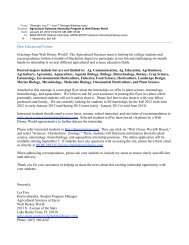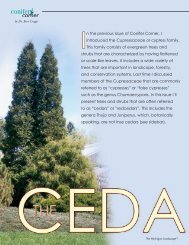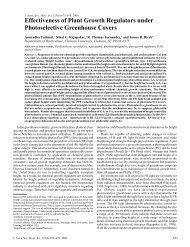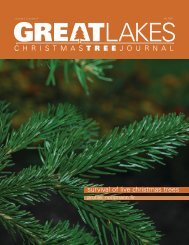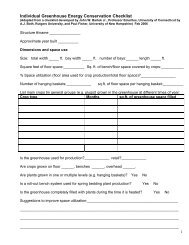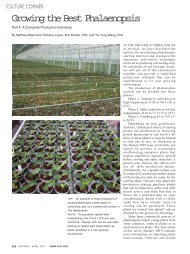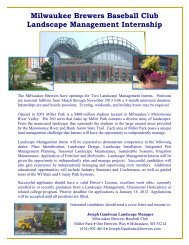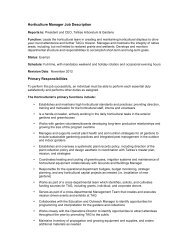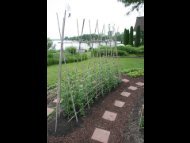concolor fir - Michigan State University
concolor fir - Michigan State University
concolor fir - Michigan State University
You also want an ePaper? Increase the reach of your titles
YUMPU automatically turns print PDFs into web optimized ePapers that Google loves.
conifer species profile<br />
spring 2009<br />
great lakes christmas tree journal<br />
Range map of<br />
Abies <strong>concolor</strong>.<br />
Concolor <strong>fir</strong> has a<br />
wide but disjunct<br />
distribution in<br />
the Southwest,<br />
resulting in a<br />
high level of population<br />
variation.<br />
Concolor <strong>fir</strong> is among the <strong>fir</strong>st species to<br />
break bud and therefore susceptible to<br />
late frosts.<br />
Concolor <strong>fir</strong>’s combination of adaptability and aesthetic<br />
appeal make it the most widely used true <strong>fir</strong> in the<br />
landscape trade in the eastern United <strong>State</strong>s. Concolor<br />
<strong>fir</strong> is rated as hardy to zone 3 or zone 4 so it can survive<br />
winter throughout the Great Lakes region.<br />
late frost injury. Concolor <strong>fir</strong> is a good<br />
grower and growth rates are comparable<br />
to Fraser <strong>fir</strong>. Culturing <strong>concolor</strong> can take<br />
a little extra effort compared to Fraser,<br />
however. According to grower Dan<br />
Wamhoff, “Concolor can produce a good<br />
Christmas tree in a reasonable time, but<br />
tops can have some erratic growth and<br />
require some top-work to maintain a<br />
good leader.” While <strong>concolor</strong> <strong>fir</strong> cannot<br />
be considered ‘pest-free’ it generally has<br />
fewer pest problems than many other<br />
Christmas tree species. Like most <strong>fir</strong>s,<br />
Concolor is susceptible to balsam twig<br />
aphid and spider mites.<br />
Genetics<br />
As noted earlier, only the Rocky<br />
Mountain form of Concolor <strong>fir</strong>, var. <strong>concolor</strong>,<br />
is suited for planting in the Great<br />
Lakes region. Seed sources within the<br />
Rocky Mountains also show considerable<br />
variation. Provenance testing and grower<br />
experience indicate Santa Fe, Cibola, San<br />
Juan, and Rio Grande seed sources rate<br />
the highest in terms of overall growth,<br />
color and form. In a provenance test in<br />
Idaho the seed sources were ranked<br />
Rio Grande (NM)<br />
Santa Fe (NM)<br />
Cibola (NM)<br />
Kiabab (AZ)<br />
Lincoln (NM)<br />
Kaibab ranked below the <strong>fir</strong>st three<br />
due to slow growth rate. Lincoln was the<br />
fastest grower but experienced problems<br />
with twisted and/or multiple leaders.<br />
Needle retention also varies among seed<br />
sources. In a comparison of needle<br />
retention among <strong>concolor</strong> <strong>fir</strong> provenances<br />
at Penn <strong>State</strong>; Santa Fe and Rio Grande<br />
had the best needle retention, Apache<br />
had the poorest, and Lincoln was intermediate.<br />
Overall quality ratings of the<br />
seed sources during a 35-day display followed<br />
the same trend.<br />
Landscape use<br />
Concolor <strong>fir</strong>’s combination of adaptability<br />
and aesthetic appeal make it the<br />
most widely used true <strong>fir</strong> in the landscape<br />
trade in the eastern United <strong>State</strong>s.<br />
Concolor <strong>fir</strong> is rated as hardy to zone 3<br />
or zone 4 so it can survive winter<br />
throughout the Great Lakes region. As<br />
note earlier, <strong>concolor</strong> <strong>fir</strong> will tolerate<br />
poorer drainage and more alkaline soil<br />
pH conditions than most other <strong>fir</strong>s. It is<br />
important to keep in mind, however, that<br />
these tolerances are relative to other <strong>fir</strong>s;<br />
<strong>concolor</strong> will not do well in heavy clay<br />
or in standing water. Success of transplanting<br />
landscape-sized <strong>concolor</strong> <strong>fir</strong>s is<br />
usually high to good. Depending on the<br />
nursery site trees may sink some deep<br />
large roots, which makes lifting a challenge<br />
and increases loss of roots in transplanting.<br />
Standard techniques to<br />
6



